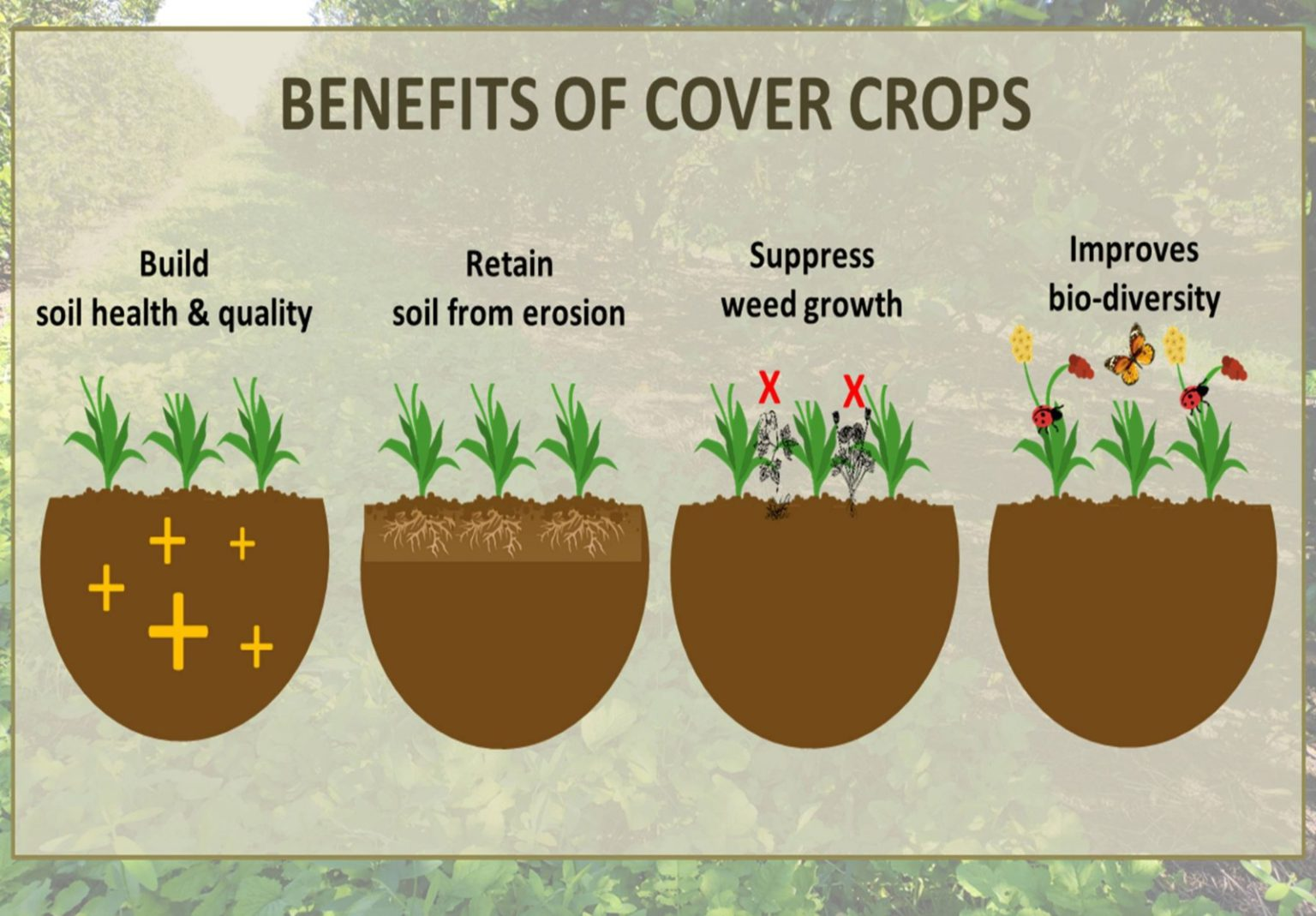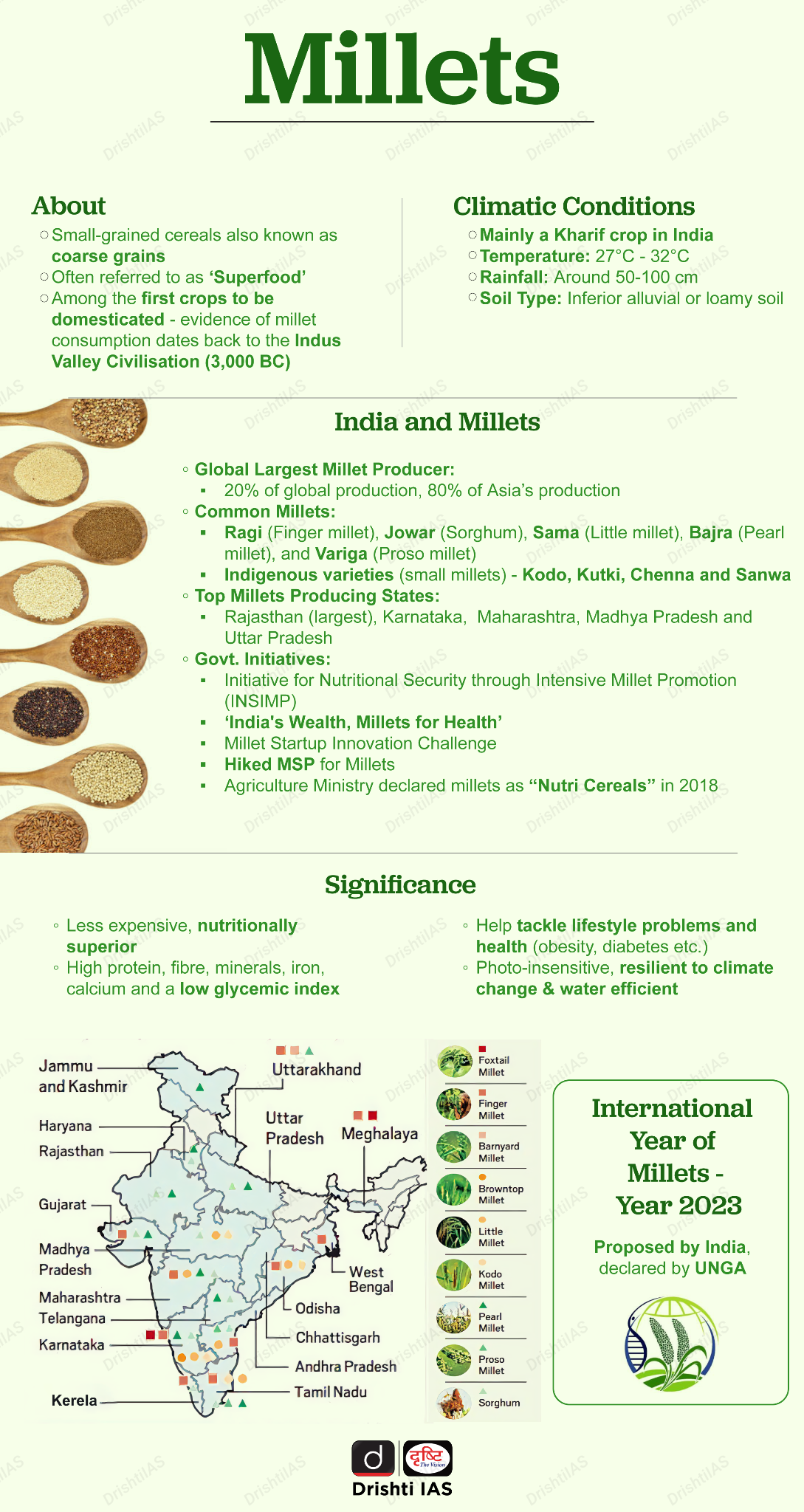Agriculture
Millets for Sustainable Agriculture
This editorial is based on "The paddy pivot: Rethinking subsidies to drive sustainable farming", published in Financial Express on 05/05/2025. The article highlights the need to repurpose the current government expenditures to move away from intensive paddy production to the production of alternative crops like millets that are more sustainable.
For Prelims: India’s paddy cultivation, methane and nitrous oxide emissions, Government schemes related to Millet Production, FCI, Food Production, Government subsidies and MSP
For Mains: Agricultural Reforms, Environmental impacts of paddy production.
India’s paddy cultivation, which has long supported millions of livelihoods, is now being seen as a barrier to the nation’s environmental and economic sustainability. As of 2023-24, paddy occupies 36% of the total area under food grain production, which is approximately 47.82 million hectares. It comes at a high environmental cost, contributing to methane and nitrous oxide emissions and exacerbating water usage concerns.
Furthermore, states like Punjab and Haryana, despite their long history of paddy farming, now show declining agricultural growth rates. This has triggered a debate on the need to adopt Sustainable Agricultural Practices like millets production.
What is Sustainable Agriculture?
- About: Sustainable agriculture refers to farming methods that meet current food and textile needs without compromising the ability of future generations to meet their own needs.
- Aim: These practices aim to create a balance between agricultural productivity, environmental health, economic profitability, and social equity.
- Sustainable agriculture focuses on minimizing the use of non-renewable resources, promoting biodiversity, enhancing soil health, and reducing the impact on ecosystems.
- Key Characteristics:
- Conservation Centric: Efficient irrigation techniques like drip irrigation, rainwater harvesting, and water-efficient crop management to minimize water wastage.
- Techniques such as crop rotation, agroforestry, reduced tillage, and the use of organic fertilisers to preserve soil fertility and structure.
- Organic Farming: Avoiding synthetic pesticides and fertilisers, relying on organic alternatives to maintain healthy soil and ecosystems.
- Integrated Pest Management (IPM), combining biological, cultural, and mechanical control methods to manage pests and reduce dependence on chemical pesticides.
- Climate-Resilient Crops: Growing crops that are more resistant to droughts, floods, pests, and diseases, which helps farmers adapt to climate variability.
- Planting trees to absorb carbon dioxide from the atmosphere, helping mitigate climate change.
- Minimizing practices such as paddy cultivation, which emits large amounts of methane, and adopting low-carbon farming practices.
- Conservation Centric: Efficient irrigation techniques like drip irrigation, rainwater harvesting, and water-efficient crop management to minimize water wastage.

What are the Key Advantages of Millet Production?
- Enhanced Food Security: Millets are highly nutritious, rich in protein, fiber, and essential minerals, offering a healthy alternative, aiding in the management of diabetes and promoting better digestion and heart health.
- Environmental Sustainability: Millets are drought-tolerant, requiring minimal water, fertilizers, and pesticides, making them ideal for cultivation in arid and semi-arid regions. This helps conserve water and protect the environment.
- Economic Viability for Farmers: Millets have a lower cost of production, leading to higher profit margins for farmers. They also offer diversification, reducing economic risks associated with monocropping.
- Rural Livelihood Support: Millet cultivation provides employment opportunities in rural regions, especially in dryland areas, and can improve incomes through both food production and livestock fodder.
- Global Market Expansion: India is the largest producer and exporter of millets, followed by Niger and China. Global millet production stood at 28 million metric tons in 2020, with major consumption in Africa and Asia.
- Support for SDGs:Promoting millet production aligns with global goals like Zero Hunger, Climate Action, and Clean Water, contributing to sustainable agriculture and climate resilience.
What are the Challenges in Moving Away from Paddy Cultivation in India?
- Economic Factors: Despite the environmental and resource-intensive nature of paddy cultivation, it continues to be economically lucrative for farmers. For example, the gross profit from paddy farming is notably high in states like Punjab as per data from 2023-24.
- On the other hand, millets (e.g., bajra and jowar) are more environmentally sustainable due to their lower water and fertiliser requirements, but they are not as profitable as paddy.
- The substantial subsidies provided by the government to paddy production, including fuel and electricity subsidies for irrigation and fertilisers, make it an economically attractive choice for farmers.
- Farmers' Resistance to Change: Farmers are inherently risk-averse when it comes to switching crops. Since agriculture is highly dependent on weather conditions, yield fluctuations, and market prices, there is a significant psychological barrier.
- Farmers are not convinced that switching to millets, despite the environmental benefits, will guarantee the same or better profits, especially when the price for millets can vary significantly from year to year.
- Millets, while resilient and less resource-intensive, may yield less per hectare compared to paddy under current farming conditions.
- Infrastructural and Knowledge Gaps: There is a lack of infrastructure for millet processing and marketing, especially in comparison to paddy.
- While paddy has an established supply chain and processing infrastructure, millets still face challenges related to storage, transportation, and market access. This hampers the commercial viability of millets.
- Many farmers in traditional rice-growing states like Punjab and Haryana lack the technical know-how for growing millets. This knowledge gap needs to be addressed through government initiatives and agricultural extension services.
- Cultural and Social Factors: Farming in states like Punjab and Haryana is deeply embedded in cultural and traditional practices, where paddy cultivation has been passed down through generations.
- The idea of switching crops is not only an economic decision but also a cultural one.
- Overcoming this social inertia requires a concerted effort to change the mindset of farmers about the benefits of millet cultivation.
- Policy Gaps and Regulatory Constraints; While the government has increased awareness about millets through campaigns like the International Year of Millets (2023), there is still a gap in the policy support structure when it comes to incentivizing large-scale millet cultivation.
- The focus has predominantly been on food security through staple crops like rice and wheat, and millets have often been overlooked in terms of government procurement, MSP support, and subsidies.
What are India's Initiatives Related to Sustainable Agricultural Practices?
What Steps can be taken to Promote Sustainable Agriculture?
- Shift Paddy Production to Resource-Abundant Regions: States like Chhattisgarh, Jharkhand, and Bihar have abundant land and water resources, making them ideal for expanding paddy production.
- On the other hand, Punjab and Haryana, contributing only 8.8% and 3.8% to the national food grain pool, can reduce paddy production without jeopardising food security.
- Provide Financial Incentives for Sustainable Practices: To encourage farmers to adopt environmentally beneficial practices, financial incentives are crucial.
- The current incentive mechanisms must be overhauled to ensure that paddy farmers are adequately supported while maintaining economic welfare and food security.
- Studies suggest doubling the incentive to ₹35,000 per hectare, equally shared by the central and state governments, would make the switch to sustainable crops like millets more attractive.
- Repurpose Government Expenditure: The government spends significant resources on paddy production and procurement.
- In 2023-24, Punjab and Haryana spent ₹1,55,004 and ₹83,836 per hectare, respectively, on paddy subsidies, almost three times the gross profit earned by farmers.
- Redirecting this expenditure towards millet production can ease the fiscal burden on the government, promoting a shift to more resource-efficient crops.
- Establish Funds via Direct Benefit Transfer (DBT): A DBT system can provide cash incentives to farmers who do not grow paddy, encouraging them to switch to sustainable crops like millets or leave the land fallow.
- Governments can jointly offer cash incentives equal to or greater than the gross profit of paddy farmers—suggested at ₹53,479 per hectare.
- Fiscal Savings and Reinvestment: By halving government expenditure on paddy subsidies and procurement, the government could save over ₹6 lakh crore in Punjab and Haryana over the next decade.
- These savings can be reinvested into creating a price stabilisation fund for millets, building infrastructure to promote millet exports, and supporting environmental rejuvenation.
Conclusion:
There is an urgent need for Indian agriculture to rethink its practices in pursuit of sustainability and move away from intensive paddy production to millet production. It is possible by providing cash incentives to farmers through initiatives like a DBT system, making it a win-win situation for all – farmers, the government, and the economy. Such incentives would not only encourage farmers to adapt to new practices, but they would also lead to greater agricultural sustainability.
|
Drishti Mains Question Despite its high water consumption and environmental impact, paddy continues to dominate India’s cropping patterns. Discuss the reasons for this trend and suggest sustainable alternatives to ensure food and ecological security. |
UPSC Civil Services Examination, Previous Year Question (PYQ)
Mains:
Q. How and to what extent would micro-irrigation help in solving India's water crisis? (2021)
Q. What are the major factors responsible for making the rice-wheat cropping system unsustainable in India? (2020)





